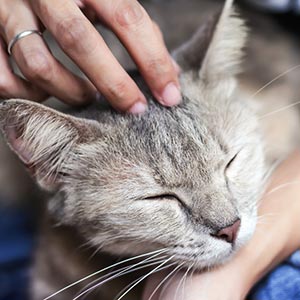The 3-3-3 Rule for Adopting a Rescue Cat
The 3 days, 3 weeks, 3 months Guidelines are just that – guidelines. Every cat will adjust a little differently. Outgoing felines might feel like the master of their new home after only a day or two; others may take six months or longer to build up their confidence and form strong bonds with their people. The things discussed here are what you can expect for an average cat, so don’t worry if your new family member adjusts at a slightly different speed.

In the first 3 days
- May not eat or drink much
- May not have normal eliminations in the litter box, or only use it at night
- May want to hide most of the time. Try giving them access to only a single room so you know where they are hiding
- Not comfortable enough to show their true personality
- May show different behavior than what you saw when you met them at the shelter. They had adjusted to their shelter habitat, and your home is very different and new!
Rather than giving your cat access to your entire home, pick a single room with a door that shuts and set them up with all necessary resources: food, water, litter box, scratcher, bedding, and some toys/enrichment items. It is normal for your cat to not eat or drink much (or at all) or interact with their enrichment in the first few days. Be sure to block hard-to-access hiding spots: under beds and couches, and dark corners of closets. Offer hiding spots such as cardboard boxes, cave-style cat beds, or blankets draped over a chair with an open underside. Hang out in the room but don’t force attention on them if they don’t seem interested. This is a great time to get them used to the sound of your voice and your presence in general.
If you ‘lose’ your cat in the room and are unsure where they are hiding, don’t panic! Resist the urge to start moving furniture or empty out your closet. Loud noises, moving of hiding places, and sudden movements will be stressful for your new kitty, and doing this while they’re still adapting to their new home can make them feel unsafe. Watch for signs that they are indeed still in the room: food is being eaten overnight, litter box being used, etc. Don’t be shocked if a cat that seemed really outgoing at the shelter wants to hide for the first few days. Most cats are nervous in new environments.

After 3 weeks
- Starting to settle in and adjust to the routine
- Exploring their environment more. May engage in behavior like jumping on counters, scratching furniture, etc. as they learn what boundaries exist and try to make themselves feel at home
- Starting to show more of their true personality
- Will likely become more playful, more toys and enrichment should be introduced
- Starting to trust you
By this point, your cat will likely start to feel more comfortable and begin to adjust to your routine. Do your best to be consistent with meal times especially! They will be showing more of their true personality and likely become more playful and active. They might approach you for attention, or be more willing to let you approach them to offer attention. They should be eating, drinking, using the litter box, and interacting with their toys and enrichment – even if it is still only when you are not in the room with them. You can check to see if things have been moved around or if scratchers show signs of use. If they are eliminating outside the box, not eating or drinking, and not engaging with any enrichment, please email our cat behavior hotline: catbehavior@humanesocietysoco.org.
If your cat already seems confident in their designated room during this period, you can open the door and let them begin to explore the rest of the house – just be sure that they always have access to their ‘safe room’ so they can run back to it if they get spooked! Never force them to leave the room, it should always be their choice. If you have other animals in your home, rather than opening up the house to your cat, this is when you may be able to begin the introduction process. Be sure to wait until your cat seems comfortable and confident in their single room. Very shy cats may take longer than 3 weeks before they are ready to start this process.

After 3 months
- Adjusting to the household routine, will expect meal at regular times
- Feeling confident that they belong in the home
- A real bond is forming with you, which will continue to grow
- Playful, interested in toys and enrichment
Your cat is most likely confident and comfortable in your home and has acclimated to meal-time routines. They should be playing with you and utilizing enrichment on a daily basis, showing affection in whatever their preferred way is, and should not be fearfully hiding most of the day; while it is normal for cats to nap or hang out in hidey holes, or get spooked by new visitors or big changes and temporarily go into hiding, if they are spending much of their time acting fearful or are still very wary of the members of your household you should reach out to our email cat behavior hotline for help. If you have not already started the introduction process with any other animals in your household, now is the time when it is likely fine to begin.
Remember, each cat is different and may not adjust exactly along this timeline! Cats are also different in how they show affection. Some may want to cuddle endlessly with you, others will be perfectly content to curl up at the other end of the couch! Building your bond and appreciating the nuances of personality are just two of the great joys of cat companionship!
We recently adopted “Etch-a-Sketch” the cat. I have renamed him “Stretch”. And just to let you know, we’re so very delighted with him. He even gets along with my dog — well, he bosses the dog around, ha ha ha. But yes, we are all getting along great, and you seriously helped me find the exact type of cat that I was looking for. So thank you very much for your services, and hope you all have a great day.